Perhaps some kind soul bestowed a Norfolk Island pine upon you during the holiday season. And you kept this festive houseplant alive – nice work!
Now you are contemplating the task of repotting this lovely living Christmas tree.
Fear not, this is not such a grueling task – and you may even want to skip it! You’ll find out what I mean shortly.
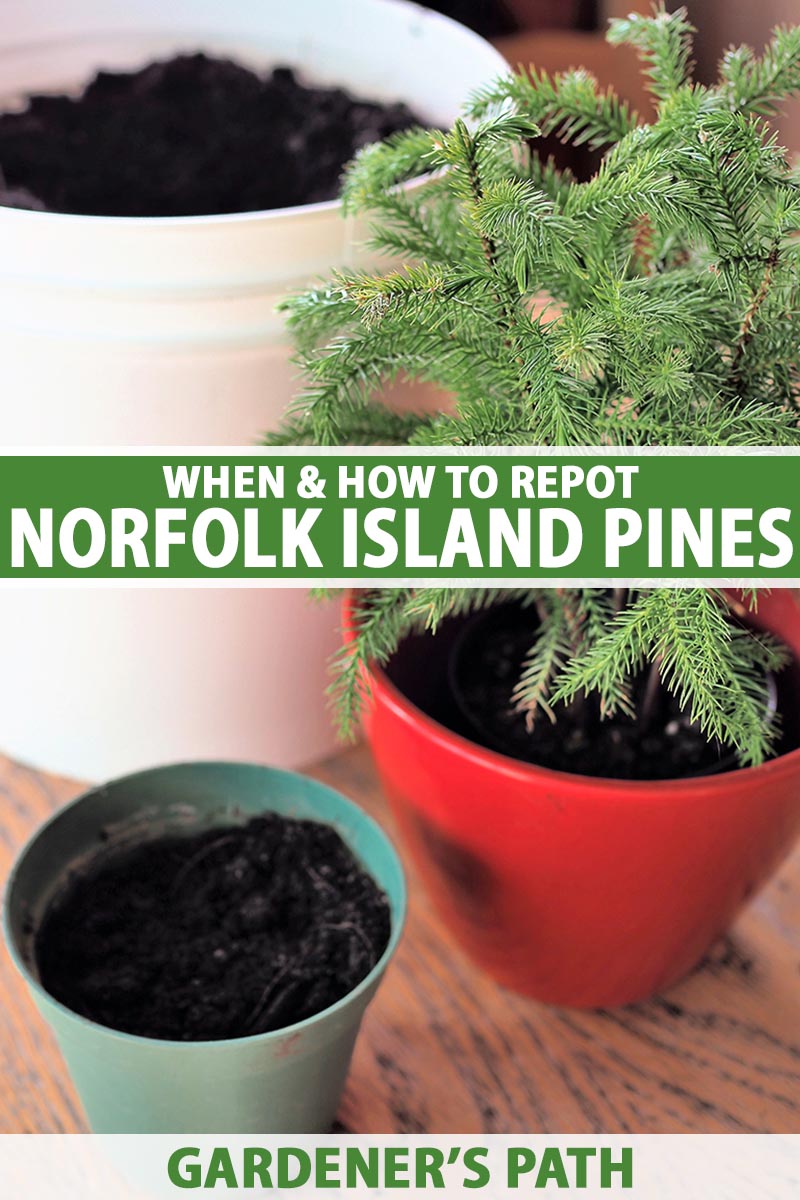
We link to vendors to help you find relevant products. If you buy from one of our links, we may earn a commission.
I’m going to cover the pros and cons of replanting Norfolk Island pines as well as some alternate solutions.
I’ll also explain the best timing for the task, as well as the supplies you’ll need. And I’ll provide detailed guidelines for accomplishing this task.
Here’s everything that’s coming up:
What You’ll Learn
Why You Might Not Want to Repot
Repotting your living Christmas tree may seem like an element of standard care. Houseplants do grow while they’re inside our homes, after all, so they must need bigger containers from time to time – right?
But there’s a reason why you might choose to skip this routine houseplant maintenance task, or at least do it very infrequently.
As many seasoned Norfolk Island pine owners know, these coniferous trees can eventually outgrow our homes.
While they aren’t actually pines, they are, indeed, trees. These are trees which can grow to be one to two hundred feet tall when planted outdoors!
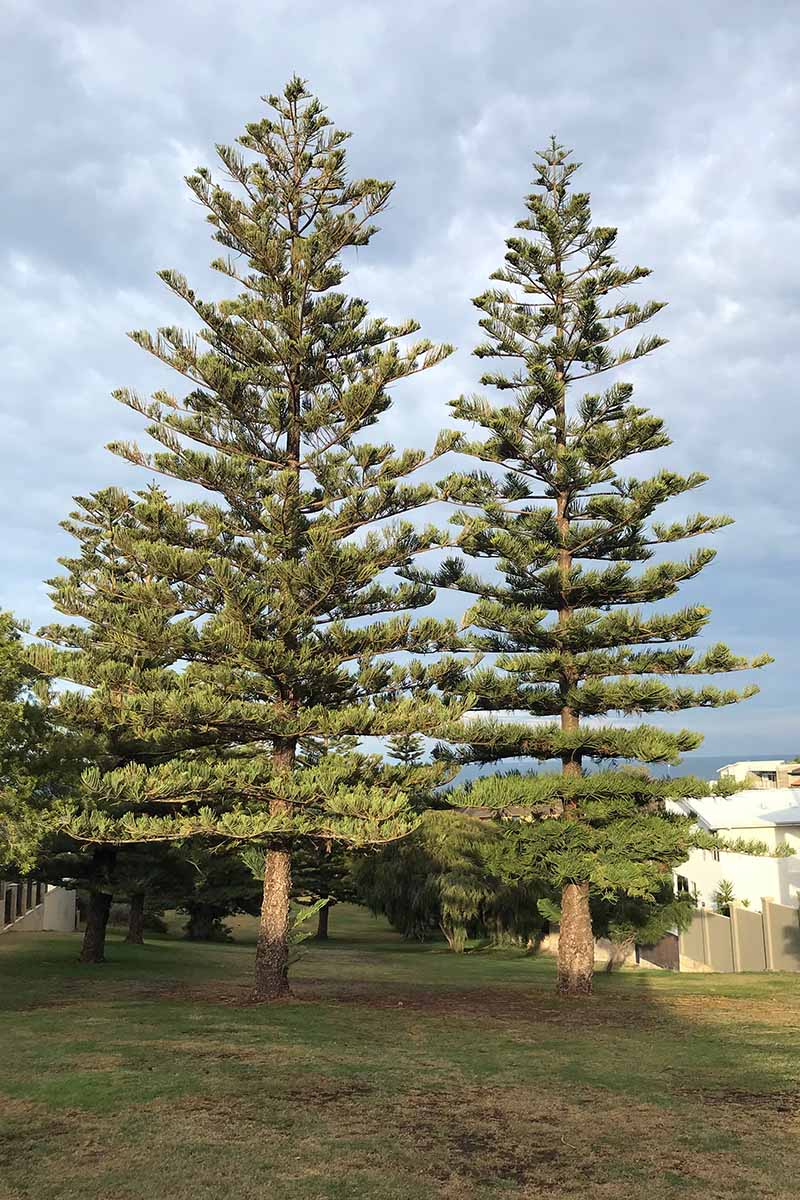
One way we can keep these conifers from outgrowing our homes too quickly is to limit the frequency of repotting.
Gerard Klingman, retired horticulturist at the University of Arkansas Agricultural Extension, explains that by limiting the container size of this houseplant, we can restrict its root growth and can keep the conifer at a more manageable size for our households.
If this sounds strange to you, consider that Norfolk Island pines can be used to create beautiful bonsai.
This is a technique which drastically restricts the conifers’ roots, allowing us to keep them as miniatures instead of naturally maturing, towering trees.
If keeping this plant at a more manageable size by restricting its root growth sounds like a brilliant idea, I recommend you only repot when the plant is drying out too quickly between waterings – and even then, you might be able to find a better solution.
Keep reading to learn more.
When to Refresh Your Houseplant’s Soil
If you’re hoping to keep your living Christmas tree at an indoor-friendly size, you might still want to consider refreshing the plant’s soil every couple of years, but returning the conifer to the same pot.
Soil can break down and become compacted over time, so an occasional freshening up can help keep your specimen healthy, and its roots well-aerated.
Another highly recommended time to switch out your living Christmas tree’s soil is when your plant has experienced root rot, a condition that tends to arise from either poor drainage, overwatering, or some other factor that leads to soggy roots.
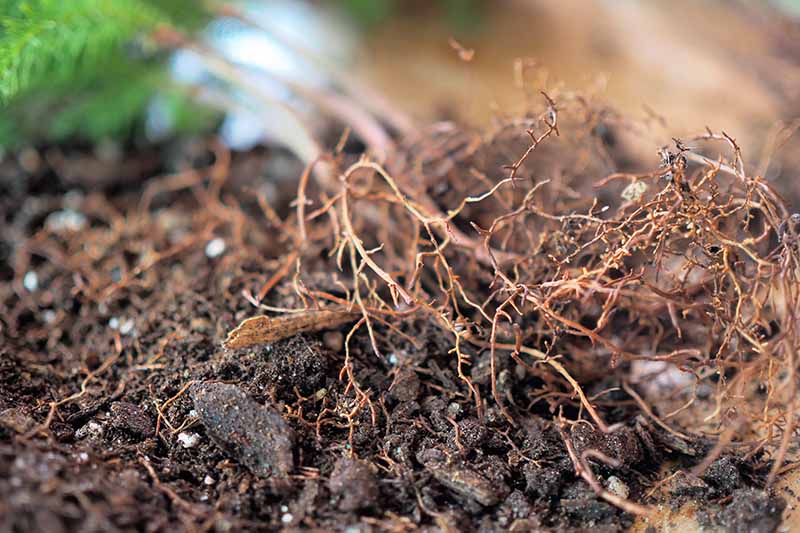
In the case of root rot, you should inspect your plant’s roots and trim away any that are dead or rotting.
Then replace the old soil with fresh growing medium, and transfer to a pot that is well-sized for the roots of your tree – this may mean moving your houseplant to a smaller container if an oversized pot was a factor that led to rot.
Finally, if your tree is drying out too quickly between waterings, and the reason seems to be a growing medium that doesn’t have enough water retention, consider keeping the same sized pot but switch to a growing medium with better water retention.
A note on this point – soil that is well-suited to one climate may not be ideal in another, so take your indoor temperature and relative humidity into account when choosing a soil mix.
When to Move to a Larger Container
Have high ceilings? If, on the other hand, you aren’t concerned about restricting your houseplant’s growth, you can transfer your living Christmas tree to a larger container every year or two.
Keep in mind that it’s best to transplant when your specimen is in a period of active growth, in spring or summer. Doing so will permit your houseplant’s roots to grow into their newly expanded soil home at the ideal time.
Choosing a Growing Medium
Dwelling in coastal areas in its native habitat, the Norfolk Island pine grows in sandy, chalky loam in the wild.
That means it’s a good idea to choose a growing medium that has some sand in it for your houseplant.
This sand isn’t just intended to make the plant feel at home symbolically. It will help to provide good drainage as well as stabilizing the tree in its container, helping it remain firmly upright.
Soil Mender’s 109 Potting Mix is my preferred growing medium for these conifers.
This peat-free mix contains coconut coir, perlite, pine bark fines, and compost, as well as sand, giving the medium both good drainage and excellent water retention.
You can purchase Soil Mender’s 109 Potting Mix at Arbico Organics.
Choosing a Container
If you’re repotting your houseplant because the growing medium has insufficient drainage, or because your plant has root rot, you can reuse the same sized container – or a smaller one, if necessary.
If you’re dealing with root rot and reusing the exact same container, make sure to sterilize it first.
Washing the container with warm, soapy water and then wiping it down thoroughly with hydrogen peroxide will help to take care of any bacteria or fungi lingering on the container’s surfaces.
On the other hand, if your specimen is healthy, you can skip the sterilization step if repotting in the same container.
When transferring your plant to a larger container, choose one that is only one size larger. This will allow a bit more room without promoting soggy roots. Clean and sanitize it before use.
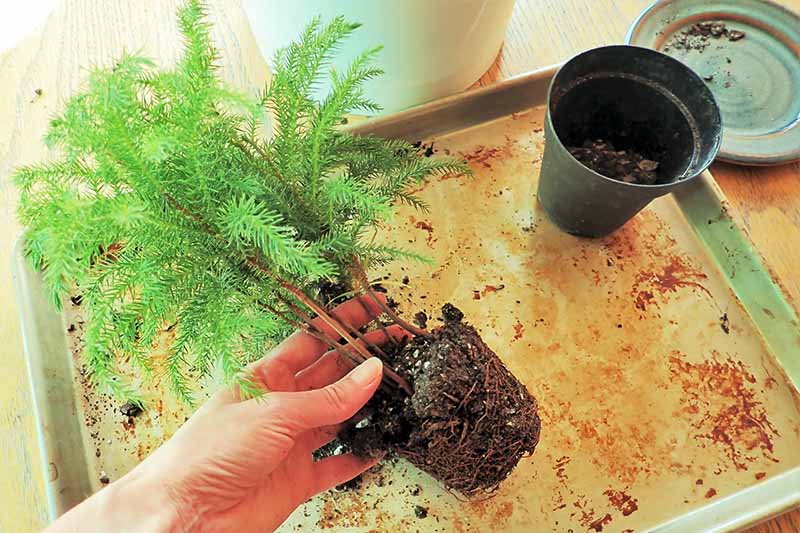
Making sure the pot has drainage holes is just as important as picking an appropriately-sized container – this will help to prevent the dreaded root rot.
If you have a decorative cachepot that you love but which has no drainage holes, place the houseplant first in a plastic or terra cotta container with drainage holes, and then set it inside the decorative pot.
Are you wondering if you should use terra cotta or plastic? If you live in an arid climate or are a bit absentminded about watering, pick plastic, which will retain moisture longer.
On the other hand, if you are the type of plant parent who tends to overwater, you might try terra cotta.
It will allow moisture to evaporate more quickly, helping to make up for your overzealousness with the watering can. (Hey, no judgement, it’s just about knowing one’s weaknesses and adjusting accordingly!)
How to Repot
When it’s finally time to repot, gather your supplies first. You’ll need some growing medium as well as a new container if you are transferring your living Christmas tree to one that is larger, smaller, or better-draining.
Once you have your supplies gathered up, start by gently tipping the plant out of its current container.
If this proves to be harder than it sounds, pull (gently!) on the houseplant at the base of the trunk rather than grabbing it by its branches.
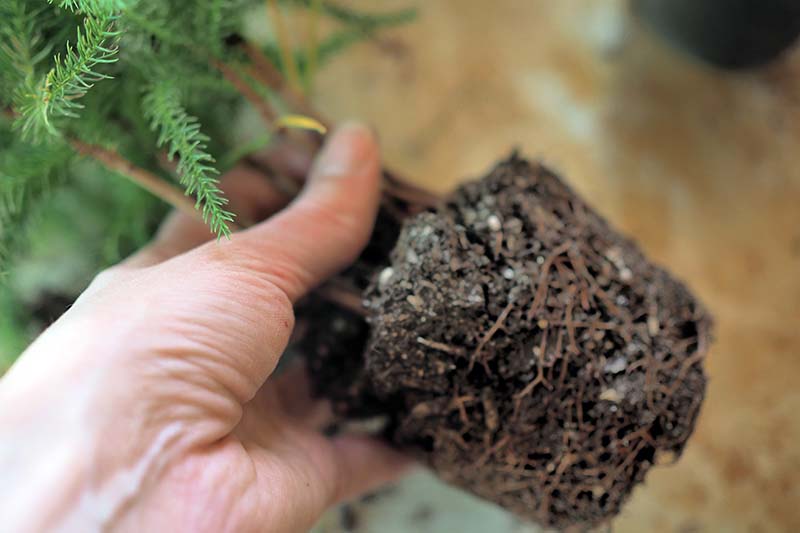
Once you have extricated your houseplant, try to loosen up the roots of the plant next.
If your conifer is rootbound, this may require a bit more work. For tightly bound roots, rub your hand along the edges of the root ball until the roots start to loosen up and are sticking out.
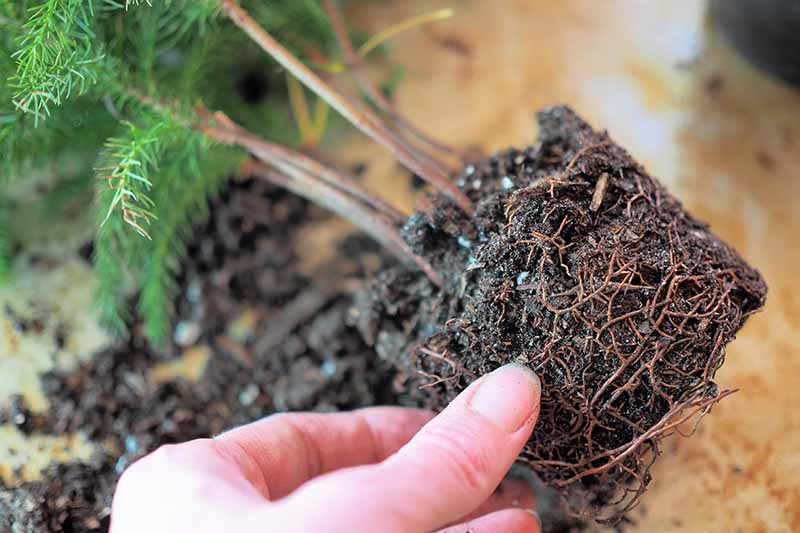
On the other hand if your old soil mix was very chunky and loose, the roots may easily come completely free of the old soil.
If the roots are healthy and have a fair bit of soil left around them, try loosening a bit of the soil out so that you can mix it in with your new soil. This will help water transfer between the two soil mediums – you’re creating a bridge between the old and the new.
However, if you are repotting because of root rot, try to remove as much of the old soil as possible.
Now, place a little of your new soil in the bottom of the container and situate your plant.
Make sure the tree’s crown is about half an inch (for smaller specimens) to an inch (for medium-sized specimens) to two inches (for larger specimens) below the rim of the container.
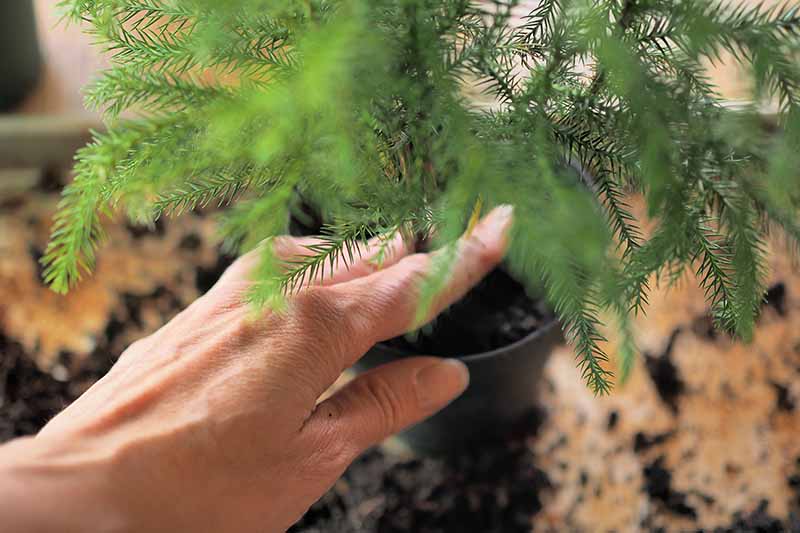
Once your houseplant is well-situated, fill the container in with your growing medium. Carefully avoid burying the crown of the tree in potting soil – keep it at the same level in the soil as it was growing before, unless it was planted too deeply.
If your plant looks like it’s either too deep or too high in the container, adjust the amount of soil beneath the root ball and reposition it.
Leaving half an inch to two inches of space (depending on the size of your container) between the surface of the soil and the rim of the container will help ensure that you can water without splattering soil over the edge.
Tap the bottom of your newly transferred conifer lightly on your work surface to settle the soil in, and add more growing medium if needed.
Water your plant in and return it to its usual location. Voila, you’re done!
To Repot or Not, That Is the Question
Now that you know the proper techniques for repotting your living Christmas tree, first you’ll have to decide whether you do indeed need to carry out this procedure – or not!
And if you want to learn more about growing and caring for this festive houseplant, be sure to read our complete guide to growing and caring for Norfolk Island pines.

Are you rethinking your decision to repot your conifer in order to restrict the growth of your houseplant?
Or are you on board for a giant living Christmas tree that will raise its branches right up to the top of your cathedral ceiling? Let us know in the comments section below.
And for more information about growing Norfolk Island pine trees, have a read of these guides next:
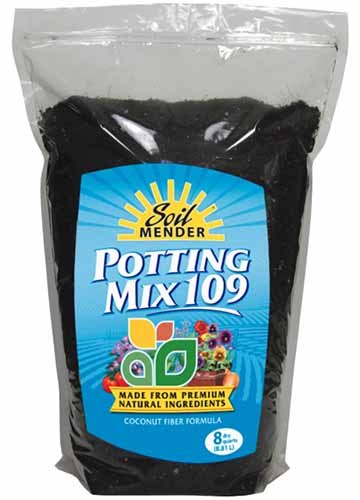



They are beautiful outside, but indoors they are neglected and filled with mites.
In the repotting section, the article says, “Carefully avoid burying the crown of the tree in potting soil…” Forgive my ignorance, but what part is the crown? Is it the area on the trunk where the branches start coming out? Thanks very much.
Hi Jeff, the crown is the part of the tree where the trunk meets the roots. You just want to make sure that the base of the trunk isn’t buried in soil, this can cause rotting.
Hope this helps!
I have a norfolk pine that did not die after christmas as usual. I’ve had it for 1 1/2 years. It is still in the plastic pot I ought it in which is 10 inches in diameter and 9 /12 inches deep I bought a terra cotta pot that is 14 inches in diameter for repotting the tree. It’s also 6 inches deeper. Is the new pot too big?
Hi Jayne, Congrats on keeping your Norfolk pine alive! Normally it’s best to only repot your plant to the next size up, so a 12″ pot would be my recommendation. If your plant is extremely root bound, you might be able to get away with moving it up to a fourteen inch pot. However, if you remove the tree from its pot and you notice that the roots aren’t taking up much room in the soil (ie, there’s still a lot of loose soil), I would actually recommend waiting to repot it for another year or two. You might want… Read more »
Hi Kristina,
Thank you. Very helpful information. I’m mad at myself for buying a pot and soil before doing the research. There is one thin string of root coming out of the bottom of the pot…
Hi, one more question…would it be okay to use a succulent potting mix?
Hi Jayne,
I wouldn’t recommend succulent potting mix for Norfolk pines – a general purpose houseplant potting mix would be better. My favorite general houseplant potting soil at the moment is this one – De La Tank’s House Plant mix.
Good luck with the repotting!
Thanks!
Hi Jayne – What growing zone are you in? I am in 6B and I keep my tree indoors. Seems the limbs dry out from our dry heat source in the winter. Any suggestions? Thank you
Hi Barb,
If your tree is drying out during the winter, it may be because of low humidity, but it may be that it’s just not getting enough water. I live in an arid climate and have low indoor humidity year round, but the branches on my Norfolk pine don’t dry out – as long as I keep it properly watered. You may want to review our main guide to growing Norfolk Island pines to make sure your water routine is right.
Hope this helps!
I have just been gifted with a Norfolk pine that my brother got when my mother passed away. 18 years ago. He has never trimmed the branches He did repot it years ago. I have so many questions. It got to hard for him to move it indoors in the winter so he kept it in a spare bedroom. He placed a piece of plywood on the bed and watered it just when he would think of it. It’s very healthy. It is about 4 ft tall from the soil level but the branches Some of them are over 6… Read more »
Hi Suzie, Thanks for sharing your story about your special plant here. So that you can make sure you’re offering it the right amount of light and water, you might want to read our main article on growing Norfolk Island pines. I’d love to help advise you on pruning your tree, but would you mind posting a photo (or a few)? Seeing the tree would help me guide you in this process, so I can make sure we are on the same page. As for separating the different trees (based on your description it sounds like there are 4 different… Read more »
I have an NP that is several years old. We recently moved to a new home and had to move in single digit weather (in MT). It was just across town, and I did wrap my tree in a sheet, but my NP is not happy. The ends of the branches are brown. I’d love to get your thoughts on what to do. Will I need to cut those branches off or do you think they may bounce back? Currently,I have moved it into our main living room (away from window in photo) where the humidity is better and still… Read more »
Hi Kjerstin, Thanks for posting your comment and sending your photo. I’ll see if one of our editors can get it to upload properly. Your Norfolk Island pine is beautiful, but yes, it looks like it’s had a bit of a shock. You didn’t mention how long ago your move was, but I think I would give the plant a bit more time to recover before doing anything. Maybe give it another month to settle in. At least half of the plant still looks green, so that’s a good sign it will be able to recover. If the plant is… Read more »
Thank you!
Hi Kjerstin, here’s your picture!
I have a Norfolk Island pine that is still in a clay pot but has been outside I think the roots have grown into the ground, I’m moving and I want to take it with me, what do I do?
Hi Melodie, You can use a shovel to dig around the pot to loosen the roots from the ground. I would try to do this as carefully as possible so that you don’t damage them – you might want to start with a fairly wide circle around the pot, and once you have a large clod of dirt dug up, you can loosen the soil and try to find the roots so that you know where they are. Once the plant is out of the ground, if it does have roots growing beyond the clay pot, go ahead and repot… Read more »
The former owners of our new home planted one out front. It looked beautiful, but we had a severe wind and rain storm and it snapped off at the base. Is there any way to preserve part of it, or since it’s detached from the root base, is it a goner. It really did look beautiful, and big poinsettias in the side planter box.
Hi Tammy, Thanks for your question and for posting your photo. I’m so sorry to hear that your Norfolk Island pine fell victim to a storm – that really is a shame, it was gorgeous. You can indeed try propagating the top of the tree – or even a side branch though side branches will never develop the pyramidal shape of the original tree. Your tree looks like it was quite large, so I’m not sure if it will be successful or not, but it’s worth a try. I would definitely use rooting hormone. You’ll find instructions for this process… Read more »
I appreciate all the information and will look forward to learning more.
One more question. If I eventually want to plant thìs out doors. When is the best time to plant the tree out doors. Does it matter how big it becomes before planting it out doors?
Hi Aylea, Most importantly, you should only plant Norfolk Island pines outdoors if you live in a USDA Hardiness Zone that is warm enough – that’s to say zones 9-11. You can learn more about this in our main growing guide for this tree. If you are in one of those zones, it would be a good idea to plant it in spring before the weather heats up too much in order to allow it to transition to outdoor living. On that notes, you’ll also need to transition it to more direct light exposure gradually before you plant it. Put… Read more »
Soil Mender 109 has been discontinued by the manufacturer and the author states it is best for my Norfolk Island Pine tree. Can the author,Kristina Hicks Hamblin, suggest a good replacement?
Hi Barb,
I have a new soil recommendation that I like even better than the one I recommended previously. One of my new favorites is Rosy Soil Indoor Potting Mix, available via Amazon.
Hope this helps!
Got it at Lowe’s! Thanks so much!